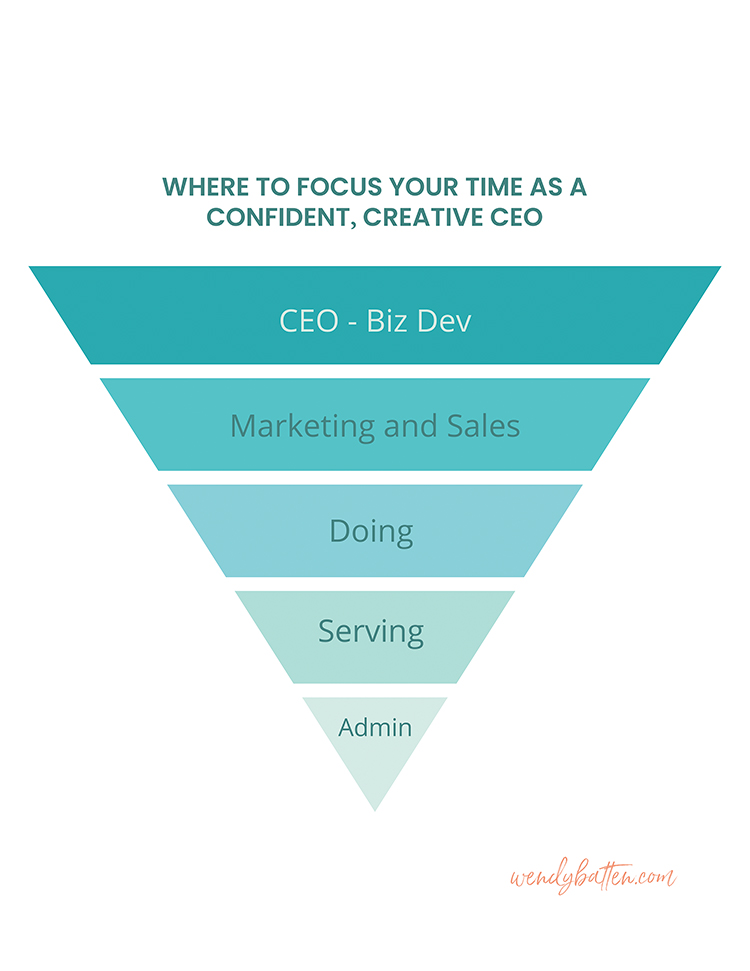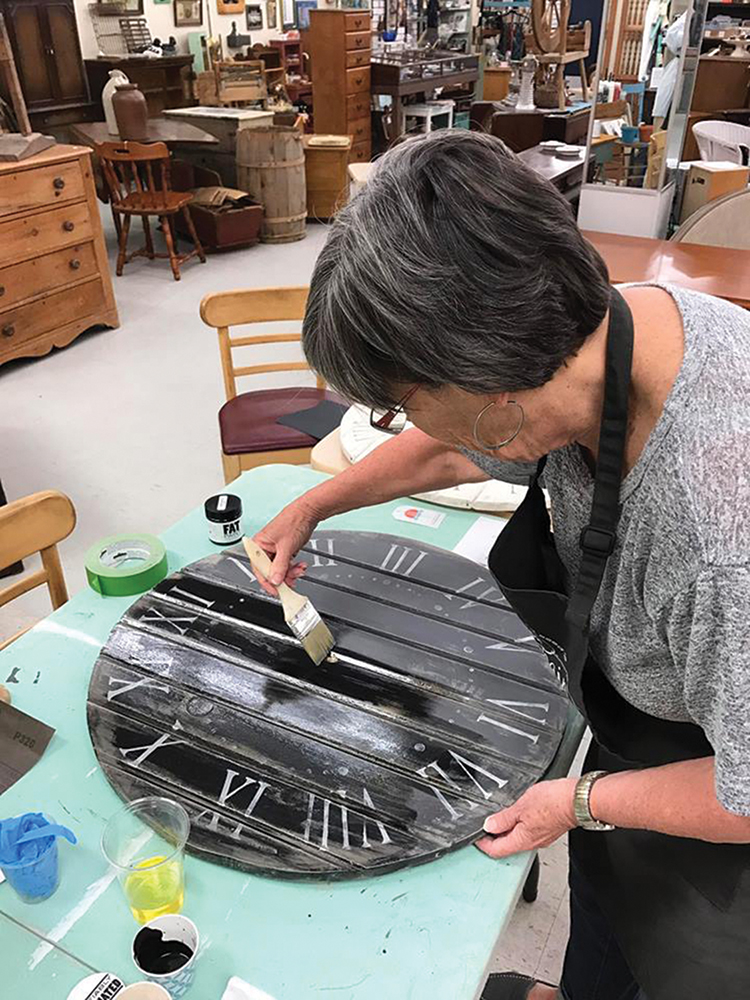Where to focus your time as a creative business owner

Welcome back to the final installment of Your Confident, Creative Business series!
I’m Wendy Batten, a retail coach with years of experience in the retail and small business trenches and, just like you, a creative soul at heart. I’m also an imperfect time manager.
Truthfully, I feel it will forever and always be something I have to be intentional about.
In this article, we’ll dive into the important topic of where to invest your precious time as a creative small business owner. It’s not about managing time: It’s about prioritizing with intention so that you can build a business that serves you and your creative lifestyle.
 The Time Conundrum
The Time Conundrum
As creative small business owners, our businesses often become an all-encompassing endeavor, leaving us little room for the creativity that drove us in the first place.
It’s important to remember that we can’t “do it all.” It’s not about being more efficient or using a better planner. The truth is: You don’t HAVE to do anything. The constant need to feel we SHOULD do everything is what causes stress and anxiety.
I’m an advocate for limiting what we do and giving our- selves permission to set boundaries, set down some of those balls we are juggling and give ourselves some grace and space.
But how?
To start, I would love for you to define your time and really think about:
1. LIFE TIME—not working on or in the business
2. WORK TIME — the actual hours you want to spend on business
Some weeks, it might be more of one or another — life happens. Set a plan for your work hours and do whatever you can to protect those “off work” times to enjoy your life.
This simple exercise feels heavy to some. It was for me (for many years): I should be working on this next proposal or I’ll just check my socials and emails really quickly. I promise, if you set some boundaries and bumpers around your “life time,” you will be so much happier and you will avoid burnout (and resentment) from your business.
Make this an executive CEO decision and give yourself permission to separate the hours. The choice is yours to make, no one else will.
I personally stopped looking at emails, DMs and notifications during life time. As a former people pleaser this was (and still is) really hard. But I made a commitment to my well-being, and my business’s well-being. I am not a brain surgeon or emergency worker, and while my small business clients are super important to me, as far as I know, no one has died from me not answering emails — and my business is doing just fine. I set the boundaries and, as a bonus, my customers seem to respect me more for it. Yours will too, so stick to work during your work hours.
So, what should we focus on during our “work time”?

Making Time for Your Business
Once you have your working hours established, you have to be intentional about where to focus that limited time.
Run Your Business by Design, Not Default
Many of us venture into business with dreams of being our own boss and setting our own rules. The reality, though, is that being your own boss is tough. To succeed, you must understand the difference between working in your business and working on your business.
We’ve established the difference between work time and life time. Now, what can we do in those work times to be most effective in our creative business?
Competing priorities, squirrel brain (shiny object syndrome is a real thing) and our natural creative curiosity get in our way a lot.
There are five key areas that need to get consistent attention in order for a business to grow and thrive. When you work on these five things, in your now-structured work hours, you WILL find a way to make it work. You will be getting the essential items done, and by focusing on what matters most.
When we have unlimited time, it fills up. When we have finite time or structured time, we will fill it with what matters most.

1. Business Development
Business development is often overlooked or used as a procrastination tool. However, investing time in improving your business foundations, acquiring new skills and staying updated is crucial for long-term success. Learning and growth should never stop.
Tasks in this category may include:
- Purposeful educational time
- Reviewing metrics/Key Performance Indicators and financials
- Quarterly and yearly planning
- Decision-making
- Vision storming for the business
- Research and development
2. Marketing + Sales
Marketing and sales are non-negotiables for any business. The time you invest here can have a significant impact on your profitability and sustainability. Putting the right strategy in place is key to your business success. Done right, marketing can yield substantial returns on your time, energy and money.
Tasks in this category include:
- Planning marketing events
- Promotional calendar planning
- Creating shop/market displays
- Community outreach/awareness
- Creating, scheduling and promoting content
3. Creative Work
Don’t forget the heart of your business — the creative work that generates income. It’s easy to get caught up in administrative tasks and neglect the very work that sustains your business.
Tasks in this category include:
- Anything that is considered your revenue-generating work

4. Customer Service/Serving Your Customers
Customer service plays a pivotal role in shaping your customers’ perceptions of your business. Exceptional customer service can turn customers into raving fans who refer others. Customer service can (and should) be limited to your working hours. (I promise you will get used to this.)
Tasks in this category include:
- Managing and responding to emails
- Handling direct messages
- In-person customer interactions
- Coordinating custom work requests
- Streamlining and delegating customer service tasks to free up your time while ensuring your clients feel well taken care of

5. Administrative and Operations
These are the essential but often time-consuming tasks that keep your business running smoothly. While necessary, they don’t directly generate revenue for you.
Tasks in this category include:
- Organizing paperwork and receipts
- Invoicing and tracking payments
- Bookkeeping and accounting
- Customer database management
- Any repeatable tasks
Recognize that these tasks can easily eat up your time, so it’s crucial to systematize, delegate or eliminate them as much as possible.

For many (myself included), this pyramid was completely inverted initially. Only when I flipped it did I see my business grow.
A HELPFUL TIP | Replace “I have to” with “I get to” and see how your mindset changes around organizing your time and doing the harder things!
Your action steps:
Keep this time pyramid handy and pay attention to where you allocate your time.
Understanding where to spend your time as a creative small business owner is the key to unlocking your business’s true potential. By prioritizing your tasks with intention and focusing on what matters in your business, you can transition from feeling like the business is running you to thriving as a creative entrepreneur.
Personally, this time pyramid helped me learn to work on what’s important and realize that working on the admin for hours and hours wasn’t my zone of genius, or making me money, so I streamlined and delegated that portion and now spend more time on the things that matter at the top of the pyramid. It’s a game-changer for me, and is for my clients, too.
Remember, it’s about making time for your life and your business’s health. Are you ready to run your business by design, not by default? Invest your time wisely and watch your creative business soar to new heights.
Connect with me if you need any support with your creative business, it would be my pleasure to help you.
Is your mission larger than your excuses?
View the rest of this series: here.








